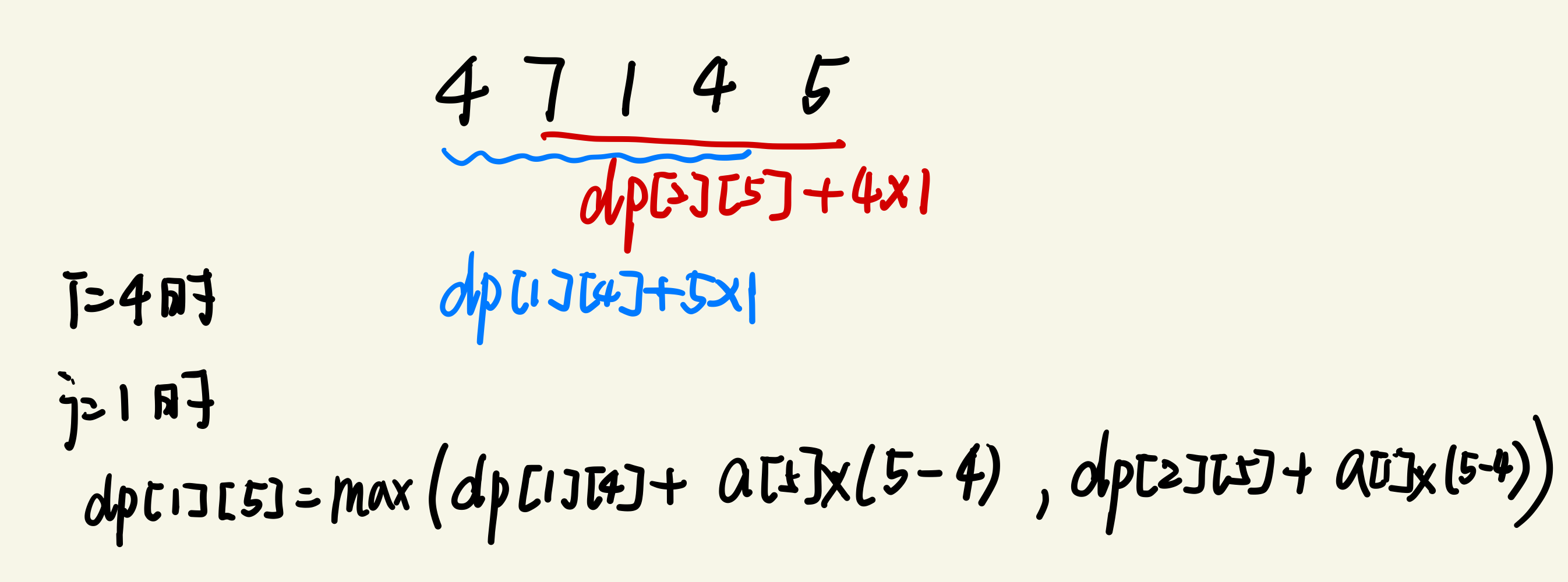ACM题解——动态规划专题——奶牛食物的最大收益
题目描述
FJ has purchased N (1 <= N <= 2000) yummy treats for the cows who get money for giving vast amounts of milk. FJ sells one treat per day and wants to maximize the money he receives over a given period time.
The treats are interesting for many reasons:
- The treats are numbered 1..N and stored sequentially in single file in a long box that is open at both ends. On any day, FJ can retrieve one treat from either end of his stash of treats.
- Like fine wines and delicious cheeses, the treats improve with age and command greater prices.
- The treats are not uniform: some are better and have higher intrinsic value. Treat i has value v(i) (1 <= v(i) <= 1000).
- Cows pay more for treats that have aged longer: a cow will pay v(i)*a for a treat of age a.
Given the values v(i) of each of the treats lined up in order of the index i in their box, what is the greatest value FJ can receive for them if he orders their sale optimally?
The first treat is sold on day 1 and has age a=1. Each subsequent day increases the age by 1.
Input
Line 1: A single integer, N
Lines 2..N+1: Line i+1 contains the value of treat v(i)
Output
Line 1: The maximum revenue FJ can achieve by selling the treats
Sample Input
5 1 3 1 5 2Sample Output
43
Hint
Explanation of the sample:
Five treats. On the first day FJ can sell either treat #1 (value 1) or treat #5 (value 2).
FJ sells the treats (values 1, 3, 1, 5, 2) in the following order of indices: 1, 5, 2, 3, 4, making 1×1 + 2×2 + 3×3 + 4×1 + 5×5 = 43.
题意
给一串序列,有n个数,你可以从序列头或者尾取数字,取的时候需要编号,第一个数,第二个数……直至取完,最终要求出如何取数字,才能使所有取出的数字与对应编码的乘积的和最大。开始我以为取得时候可以贪心,总是先取最小的,最大的就可以拖着最后取,但是实际上并不是这样的,例如 47145这个序列,看着4<5, 取4,;然后5<7,取5;3<7,取3;1<7,取1。从先到后依次为第1 5 4 3 2个取,得出的结果为 4*1+7*5+1*4+4*3+5*2=65,可是发现那个1有点太小了,想要把它先取了试一试,就按照 4 5 3 2 1 的顺序来取数字,得出结果为4*4+7*5+1*3+4*2+5*1=67 发现比上一次的结果要更大,可见左右贪心取当前最小值并行不通。
上面的方法是从外往内剥,换一个思路从内往外、从左往右推。用dp[i][j]记录序列从j开始,长度为i+1的序列的不管用某种方法得到的最大的乘积和。对于每一个序列,已知其最大乘积和,它是由比其序列长度少一得到的,只有两种情况,要么加左边,要么加右边,加的和=max(该数字*(n-已有个数))(ps:已有个数就是当前序列长度-1,括号里得到的就是序号<从减掉第一个算1开始,当还剩i+1个数时,是把它从剩i变成剩i+1个得到,这i+1的序号就为n-i>),两层循环依次类推求出最后的dp[1][n]就是最终的答案。
做一个图示过程:
代码
#include<iostream>
using namespace std;
int maxx(int x,int y)
{
if(x>y)
return x;
else
return y;
}
int main()
{
int n=0;
cin>>n;
int *v=new int [n+1];
v[0]=0;
for(int i=1;i<=n;i++)
cin>>v[i];
int **dp=new int*[n+1];
for(int i=0;i<=n;i++)
{
dp[i]=new int[n+1];
for(int j=0;j<=n;j++)
dp[i][j]=0;
dp[i][i]=v[i]*n;
}
int big=0;
for(int i=1;i<n;i++) //长度从1-n变化
{
for(int j=1;j<=n-i;j++)//左边界变化范围
{
int yj=j+i; //长度为i+1,末尾为j+i=yj
dp[j][yj]=maxx(dp[j+1][yj]+v[j]*(n-i),dp[j][yj-1]+v[yj]*(n-i));//短的补左边和短的补右边取最大值
}
}
cout<<dp[1][n-1]<<endl;
return 0;
}
今天的文章acwing动态规划_acm经典例题分享到此就结束了,感谢您的阅读。
版权声明:本文内容由互联网用户自发贡献,该文观点仅代表作者本人。本站仅提供信息存储空间服务,不拥有所有权,不承担相关法律责任。如发现本站有涉嫌侵权/违法违规的内容, 请发送邮件至 举报,一经查实,本站将立刻删除。
如需转载请保留出处:https://bianchenghao.cn/66967.html

![acwing动态规划_acm经典例题插图1 \tiny dp[j][j+i]=max(dp[j+1][j+i]+(n-i)*a[j],dp[j][j+i-1]]+(n-i)*a[j+i])](https://bianchenghao.cn/wp-content/uploads/2022/12/2022122605452522.jpg)
